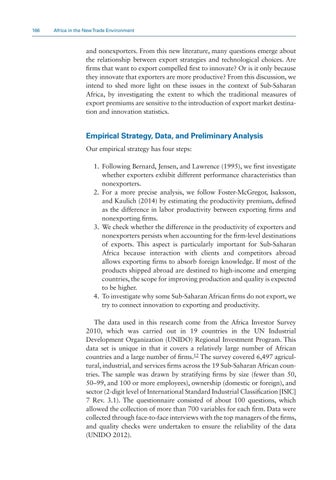166 Africa in the New Trade Environment
and nonexporters. From this new literature, many questions emerge about the relationship between export strategies and technological choices. Are firms that want to export compelled first to innovate? Or is it only because they innovate that exporters are more productive? From this discussion, we intend to shed more light on these issues in the context of Sub-Saharan Africa, by investigating the extent to which the traditional measures of export premiums are sensitive to the introduction of export market destination and innovation statistics.
Empirical Strategy, Data, and Preliminary Analysis Our empirical strategy has four steps: 1. Following Bernard, Jensen, and Lawrence (1995), we first investigate whether exporters exhibit different performance characteristics than nonexporters. 2. For a more precise analysis, we follow Foster-McGregor, Isaksson, and Kaulich (2014) by estimating the productivity premium, defined as the difference in labor productivity between exporting firms and nonexporting firms. 3. We check whether the difference in the productivity of exporters and nonexporters persists when accounting for the firm-level destinations of exports. This aspect is particularly important for Sub-Saharan Africa because interaction with clients and competitors abroad allows exporting firms to absorb foreign knowledge. If most of the products shipped abroad are destined to high-income and emerging countries, the scope for improving production and quality is expected to be higher. 4. To investigate why some Sub-Saharan African firms do not export, we try to connect innovation to exporting and productivity. The data used in this research come from the Africa Investor Survey 2010, which was carried out in 19 countries in the UN Industrial Development Organization (UNIDO) Regional Investment Program. This data set is unique in that it covers a relatively large number of African countries and a large number of firms.12 The survey covered 6,497 agricultural, industrial, and services firms across the 19 Sub-Saharan African countries. The sample was drawn by stratifying firms by size (fewer than 50, 50–99, and 100 or more employees), ownership (domestic or foreign), and sector (2-digit level of International Standard Industrial Classification [ISIC] 7 Rev. 3.1). The questionnaire consisted of about 100 questions, which allowed the collection of more than 700 variables for each firm. Data were collected through face-to-face interviews with the top managers of the firms, and quality checks were undertaken to ensure the reliability of the data (UNIDO 2012).


